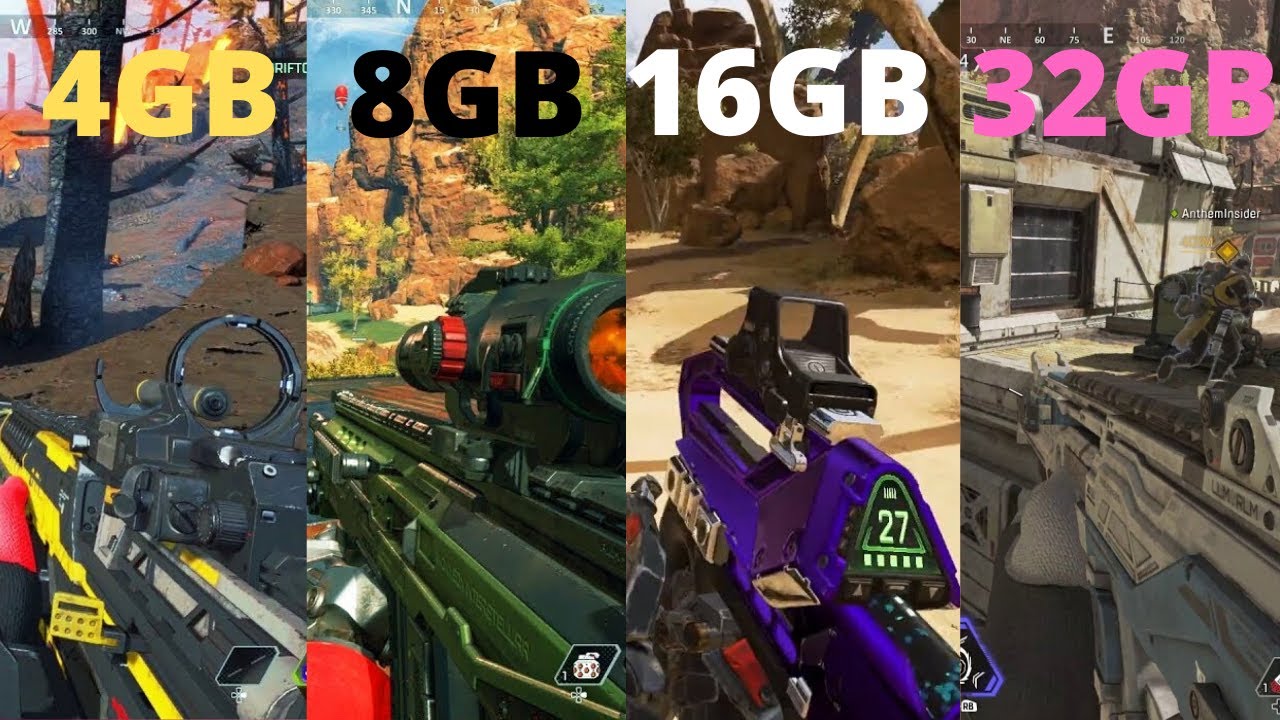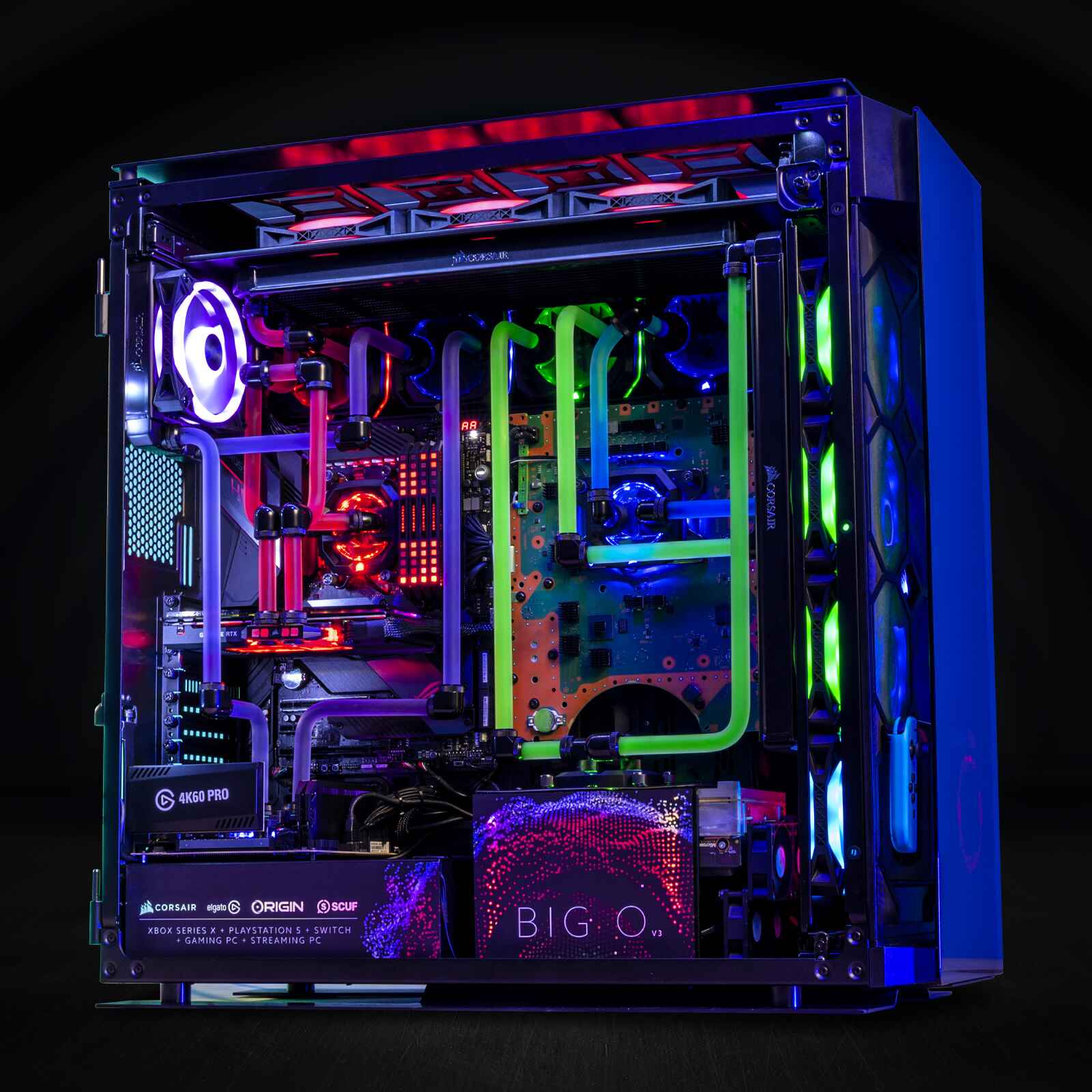Introduction
Welcome to the exciting world of Apex Legends! As an avid gamer, you might be wondering about the amount of RAM needed to run this popular battle royale game smoothly. RAM, or Random Access Memory, plays a crucial role in determining the performance of any game, including Apex Legends.
Apex Legends is a fast-paced, action-packed game that requires a significant amount of system resources to run optimally. RAM is responsible for storing and accessing data that the game requires during gameplay. Having sufficient RAM ensures that the game runs smoothly, without any lag or performance issues.
In this article, we will explore how RAM affects the performance of Apex Legends, the minimum and recommended RAM requirements for the game, and how much RAM the game typically utilizes. We will also discuss the factors that influence Apex Legends RAM usage and provide you with valuable tips to optimize your RAM usage while playing the game.
Additionally, we will examine the impact of insufficient RAM on Apex Legends performance and guide you on how to check your RAM usage while playing the game. Finally, we will share some additional tips to help you further improve your Apex Legends performance.
So, whether you’re a seasoned Apex Legends player or new to the game, let’s dive into the world of RAM and discover how it affects your gaming experience in Apex Legends!
How Does RAM Affect Apex Legends Performance?
RAM is a critical component that has a significant impact on the performance of Apex Legends. It plays a crucial role in determining the speed and efficiency at which the game can run on your system. Here’s how RAM affects your Apex Legends experience:
1. Game Loading Times: When you launch Apex Legends, the game data needs to be loaded into your RAM so that it can be accessed quickly during gameplay. Having more RAM allows the game to load faster, reducing the waiting time and getting you into the action swiftly.
2. Smooth Gameplay: Apex Legends is an intense and fast-paced game that requires quick rendering of graphics, textures, and animations. Insufficient RAM can result in lag, stuttering, and frame drops, making the gameplay experience less enjoyable. With ample RAM, the game can store and access the necessary assets seamlessly, ensuring smooth and fluid gameplay.
3. Multitasking: Many gamers like to run other applications or software in the background while playing Apex Legends, such as voice chat programs or streaming software. Having sufficient RAM allows your system to handle multiple tasks simultaneously without impacting the game’s performance. It ensures that your gameplay remains uninterrupted even when running additional applications.
4. Texture Streaming: Apex Legends utilizes a technique called texture streaming, which dynamically loads and unloads in-game textures based on the player’s location and movement. Adequate RAM allows for efficient texture streaming, resulting in sharp and detailed visuals without any texture pop-ins or delays.
5. Game Stability: Insufficient RAM can lead to crashes, freezes, or random shut-downs during gameplay. This occurs when the system runs out of memory and cannot meet the game’s resource demands. Having enough RAM ensures game stability, preventing these frustrating interruptions and allowing you to enjoy uninterrupted gaming sessions.
6. Future-Proofing: As games continue to evolve and become more demanding, having more RAM can future-proof your system. Games like Apex Legends will likely require increasing amounts of RAM with future updates or expansions. Investing in sufficient RAM now can extend the lifespan of your system and allow you to enjoy upcoming content without the need for immediate hardware upgrades.
Understanding how RAM impacts the performance of Apex Legends is crucial for optimizing your gaming experience. In the next section, we will discuss the minimum and recommended RAM requirements for playing Apex Legends.
Minimum and Recommended RAM Requirements for Apex Legends
Apex Legends, like many modern games, has specific minimum and recommended system requirements to ensure smooth gameplay. Let’s take a look at the RAM requirements for playing Apex Legends:
Minimum RAM Requirements: According to the official system requirements provided by Respawn Entertainment, the minimum RAM requirement for Apex Legends is 6 gigabytes (GB) of RAM. While it is possible to run the game with this amount of RAM, it is recommended to have more RAM for a better gaming experience.
Recommended RAM Requirements: To enjoy Apex Legends at its fullest, the recommended RAM requirement is 8 gigabytes (GB) of RAM. This additional RAM allows for smoother gameplay, faster loading times, and improved overall performance. With 8GB of RAM, you can comfortably play Apex Legends without worrying about performance issues.
It’s important to note that the RAM requirements may vary depending on other factors, such as your operating system, graphics card, and CPU. These components work together with RAM to deliver the best gaming experience. If you have a more powerful system, you may consider upgrading to 12GB or even 16GB of RAM for even better performance.
While meeting the minimum requirements is essential for playing the game, having more RAM than the minimum recommendation can provide a noticeable difference in gameplay quality. It allows Apex Legends to utilize more system resources, resulting in smoother gameplay, faster loading times, and improved overall stability.
Now that we know the minimum and recommended RAM requirements for Apex Legends, let’s delve into how much RAM Apex Legends typically uses during gameplay.
How Much RAM Does Apex Legends Typically Use?
The amount of RAM Apex Legends utilizes during gameplay can vary depending on several factors, including your in-game settings, resolution, and the number of applications running in the background. On average, Apex Legends typically uses around 2-4 gigabytes (GB) of RAM while running.
However, it’s worth noting that the RAM usage can increase during more intense moments, such as during firefights or in densely populated areas. During these peak moments, Apex Legends may use up to 6 GB or more of RAM to ensure smooth gameplay and maintain optimal performance.
The recommended amount of RAM for playing Apex Legends is 8 GB, which provides ample room for the game to run smoothly and comfortably. With 8 GB of RAM, you should have no issues running Apex Legends, even with other applications running in the background.
If you have more than 8 GB of RAM, Apex Legends may utilize the additional available memory for caching and improving overall performance. This can help reduce loading times and provide a more seamless gaming experience, especially if you have other resource-intensive tasks or applications running simultaneously.
It is essential to keep an eye on your system’s RAM usage while playing Apex Legends. Monitoring your RAM usage can help you identify if you are experiencing any performance issues related to insufficient memory. If you notice that your RAM usage is consistently high and you experience lag or stuttering, it might be worth considering upgrading your RAM to ensure optimal performance.
Now that we have discussed the typical RAM usage of Apex Legends let’s move on to the factors that influence the game’s RAM usage.
Factors That Influence Apex Legends RAM Usage
The amount of RAM that Apex Legends utilizes can be influenced by various factors. Understanding these factors can help you optimize your system and ensure smooth gameplay. Here are some of the key factors that influence Apex Legends RAM usage:
1. In-Game Settings: The in-game graphics settings you choose can have a significant impact on the amount of RAM Apex Legends uses. Higher settings, such as increased texture quality, anti-aliasing, and higher resolution, will require more RAM for optimal performance. Lowering these settings can help reduce RAM usage, but it may also affect the visual quality of the game.
2. Resolution: The resolution at which you play Apex Legends affects the amount of RAM required. Higher resolutions, such as 1440p or 4K, have more pixels to render, leading to increased RAM usage. If you are experiencing high RAM usage, lowering the resolution can help alleviate the strain on your system’s memory.
3. Number of Applications Running: Running multiple applications in the background while playing Apex Legends can increase RAM usage. Programs like streaming software, voice chat applications, or web browsers can consume additional memory resources. Closing unnecessary applications can help free up RAM for Apex Legends, improving performance.
4. System Specifications: The specifications of your computer, including your CPU, GPU, and overall system performance, can influence how much RAM Apex Legends utilizes. A more powerful system with higher-end components may be able to handle the game’s resource demands more efficiently, resulting in lower RAM usage.
5. Background Processes: Apart from the number of applications running, background processes can also impact Apex Legends RAM usage. Processes like Windows updates, antivirus scans, or system maintenance tasks can utilize system resources, including RAM. It’s advisable to close unnecessary background processes to free up memory for Apex Legends.
6. Map Location and Player Count: The specific map location and the number of players in an area can influence RAM usage in Apex Legends. More detailed environments and a higher player count require more RAM to render and process the necessary information. Areas with intense action, like hot drops or highly populated areas, can increase RAM usage during gameplay.
7. Game Updates and Patches: Occasionally, game updates or patches may alter the RAM usage of Apex Legends. Developers may optimize the game to improve performance or introduce new features that require additional memory. It’s important to keep your game up to date to benefit from these optimizations and ensure optimal RAM usage.
By considering these factors and adjusting your system settings accordingly, you can optimize Apex Legends RAM usage and enhance your overall gaming experience. In the next section, we will provide you with useful tips to optimize your RAM usage while playing Apex Legends.
Tips to Optimize Apex Legends RAM Usage
Optimizing your RAM usage while playing Apex Legends can help improve game performance, reduce lag, and ensure smoother gameplay. Here are some helpful tips to optimize the way Apex Legends utilizes RAM:
1. Close Unnecessary Applications: Before launching Apex Legends, make sure to close any unnecessary applications running in the background. This includes web browsers, music players, or other resource-intensive programs. By freeing up system resources, you can allocate more RAM to Apex Legends.
2. Adjust In-Game Settings: Experiment with the in-game graphics settings to find the right balance between visual quality and performance. Lowering settings like texture quality, shaders, and shadows can reduce the strain on your RAM and improve overall game performance.
3. Limit Background Processes: Reduce the number of unnecessary background processes that might be consuming system resources, including RAM. Disable automatic updates and other non-essential operations to allocate more memory to Apex Legends.
4. Upgrade Your RAM: If you consistently experience high RAM usage and performance issues while playing Apex Legends, upgrading your RAM can be a worthwhile investment. Adding more RAM to your system will provide more headroom for the game to run smoothly, especially if you plan on multitasking or running other resource-intensive applications.
5. Keep Your System Updated: Regularly update your graphics drivers, operating system, and the game itself. Game updates and driver optimizations can improve overall game performance, including RAM usage. Staying up to date with the latest patches and updates ensures that you’re benefiting from the game’s optimized performance enhancements.
6. Monitor Resource Usage: Use system monitoring tools to keep an eye on your RAM usage while playing Apex Legends. This can help you identify any abnormal resource consumption and take necessary actions, such as closing unnecessary applications or adjusting in-game settings, to optimize your RAM usage.
7. Restart Your System: If you’ve been using your computer for an extended period, a system restart can help clear temporary files and free up system resources, including RAM. This can result in improved performance and lower RAM usage while playing Apex Legends.
By following these tips, you can effectively optimize your RAM usage in Apex Legends and enjoy a smoother gaming experience. Remember to find the right balance between performance and visual quality based on your system specifications. With optimized RAM usage, you can fully immerse yourself in the world of Apex Legends without any performance hiccups.
The Effects of Insufficient RAM on Apex Legends
Insufficient RAM can have a significant impact on your gaming experience in Apex Legends. When your system does not have enough memory to handle the game’s resource demands, you may experience several negative effects. Here are some of the effects of insufficient RAM on Apex Legends:
1. Lag and Stuttering: One of the most noticeable signs of insufficient RAM is lag and stuttering during gameplay. When the game doesn’t have enough memory to store and access required data, it struggles to deliver a smooth gaming experience. This can lead to delayed inputs, dropped frames, and overall sluggish gameplay.
2. Increased Loading Times: Insufficient RAM can significantly increase the loading times in Apex Legends. The game needs to continuously access data from your hard drive when there isn’t enough RAM available. This causes delays in loading assets, resulting in longer waiting times between matches or when entering new areas.
3. Texture and Model Pop-In: When there is insufficient RAM, Apex Legends may struggle to load textures and models in real-time. This can result in noticeable texture pop-in, where objects in the environment may appear blurry or low-quality until they properly load. It can also cause delayed rendering of character models or environmental elements.
4. Frame Drops and FPS Drops: Inadequate RAM can contribute to frequent frame drops and lower FPS (Frames Per Second) in Apex Legends. When the game doesn’t have enough memory to store and process graphical data, the system may struggle to maintain a steady frame rate, causing the gameplay to feel choppy and less responsive.
5. Crashes and Instability: Running Apex Legends with insufficient RAM can lead to game crashes and overall system instability. When the game exceeds the available memory, it may cause the system to run out of resources, resulting in crashes or even system freezes. This can be frustrating and disruptive to your gaming experience.
6. Inability to Multitask: Insufficient RAM affects not only Apex Legends but also your ability to multitask while playing the game. If you have other applications or tasks running in the background, your system may struggle to handle both the game and these additional processes. This can lead to decreased overall performance and potential conflicts.
Having enough RAM is crucial for smooth and enjoyable gameplay in Apex Legends. Upgrading your RAM to meet or exceed the recommended requirements can significantly improve your gaming experience, allowing the game to run optimally without the issues caused by insufficient memory.
Now that we understand the effects of insufficient RAM, let’s explore how you can check your RAM usage while playing Apex Legends.
How to Check RAM Usage While Playing Apex Legends
Monitoring your RAM usage while playing Apex Legends can provide valuable insights into how your system is performing and if you might be experiencing any performance issues related to insufficient memory. Here are a few methods to check your RAM usage:
1. Task Manager: The Task Manager is a built-in Windows utility that allows you to monitor the performance of your system, including RAM usage. To access Task Manager, you can right-click on the taskbar and select “Task Manager” or press Ctrl+Shift+Esc. In the Task Manager window, go to the “Performance” tab and click on “Memory” to view your system’s current RAM usage.
2. Third-Party System Monitoring Tools: There are several third-party system monitoring tools available that provide more detailed information about your system’s performance, including RAM usage. Tools like HWMonitor, Speccy, and MSI Afterburner can give you real-time stats on your RAM usage while playing Apex Legends.
3. Windows Resource Monitor: Windows Resource Monitor is another useful tool that provides detailed information about your system’s resources, including RAM usage. To access Resource Monitor, you can open the Task Manager, go to the “Performance” tab, and then click on “Open Resource Monitor” at the bottom. In Resource Monitor, navigate to the “Memory” tab to see detailed information about your system’s RAM usage.
4. In-Game Overlay: Some gaming platforms, like Steam and GeForce Experience, offer in-game overlays that provide real-time performance monitoring, including RAM usage. These overlays can be enabled in the platform’s settings and will display your RAM usage while playing Apex Legends.
By monitoring your RAM usage while playing Apex Legends, you can identify if you are pushing the limits of your system’s memory resources. If you notice consistently high RAM usage, close unnecessary applications or consider upgrading your RAM for a smoother gaming experience.
Now that we know how to check RAM usage, let’s explore some additional tips to improve your overall Apex Legends performance.
Additional Tips to Improve Apex Legends Performance
Optimizing your system and making a few adjustments can greatly improve your overall performance while playing Apex Legends. Here are some additional tips to help you enhance your gaming experience:
1. Update Graphics Drivers: Keeping your graphics drivers up to date is crucial for optimal performance. Outdated drivers can lead to compatibility issues and poor game performance. Visit the website of your graphics card manufacturer to download and install the latest drivers.
2. Disable Unnecessary Background Applications: Close any unnecessary background applications that are running to free up system resources. Applications such as antivirus software, software updaters, or system optimizers can use valuable CPU and RAM resources that could be better utilized by Apex Legends.
3. Optimize In-Game Settings: Adjusting your in-game graphics settings can have a significant impact on performance. Experiment with lowering settings like shadows, anti-aliasing, and effects to find the optimal balance between visual quality and performance. Turning off or reducing settings that are less noticeable can help boost your frame rate.
4. Install the Latest Game Patches: Ensure that Apex Legends is up to date with the latest patches and updates. Developers often release performance optimizations and bug fixes that can enhance the game’s performance and stability. Check for updates regularly and install them to benefit from these improvements.
5. Defragment Your Hard Drive: Over time, files on your hard drive can become fragmented, which can slow down the loading time of Apex Legends. Use the built-in Windows Disk Defragmenter or a third-party disk defragmentation tool to consolidate files and improve loading performance.
6. Close Resource-Intensive Programs: Before launching Apex Legends, close any resource-intensive programs that are running in the background. Programs such as video editing software, large file downloads, or system backups can consume valuable system resources and impact game performance.
7. Disable Background Windows Services: Some Windows services can consume CPU and RAM resources needlessly. Use the System Configuration utility (msconfig) to disable unnecessary services that are not essential for Apex Legends. Carefully research and review each service before disabling to avoid impacting system stability.
8. Clean Up Your System: Regularly clean up your system by deleting temporary files, clearing cache, and removing unnecessary programs. Tools like CCleaner can assist in removing clutter and optimizing your system performance.
By implementing these additional tips, you can potentially achieve significant improvements in your Apex Legends performance. Remember to find the right balance between visual quality and performance based on your system specifications.
Now armed with these tips, you can take your Apex Legends gaming experience to the next level and enjoy smooth and immersive gameplay.
Conclusion
Optimizing your system’s RAM usage is crucial for experiencing smooth and enjoyable gameplay in Apex Legends. RAM plays a vital role in ensuring that the game runs efficiently and without any performance issues. From understanding how RAM affects Apex Legends performance to checking your RAM usage while playing the game, we’ve covered everything you need to know to optimize your gaming experience.
We discussed the minimum and recommended RAM requirements for Apex Legends and explored how much RAM the game typically uses during gameplay. We also examined the factors that influence Apex Legends RAM usage and provided valuable tips to optimize your RAM usage, including closing unnecessary applications, adjusting in-game settings, and considering a RAM upgrade.
Furthermore, we highlighted the effects of insufficient RAM on Apex Legends, from lag and stuttering to increased loading times and instability. If you are experiencing any of these issues, it may be a sign that your system’s RAM is insufficient for the demands of the game.
We also explained how to check your RAM usage while playing Apex Legends using systems tools such as Task Manager and Resource Monitor, as well as third-party monitoring software. Monitoring your RAM usage can help you identify if you need to take steps to optimize your system’s memory resources.
Finally, we provided additional tips to improve Apex Legends performance, including updating graphics drivers, disabling unnecessary background applications, optimizing in-game settings, and keeping your system and the game up to date.
By applying these tips and techniques, you can enhance your Apex Legends experience, ensuring smooth and immersive gameplay with minimal lag and interruptions.
Now, armed with the knowledge on RAM optimization, go ahead and fine-tune your system for a stellar performance in Apex Legends. Good luck, and may victory always be within your reach!
















![Is The Razer Pro Type Ultra A Gamechanger? [REVIEW]](https://robots.net/wp-content/uploads/2022/06/razer-pro-type-ultra-featured-2-300x175.jpg)








